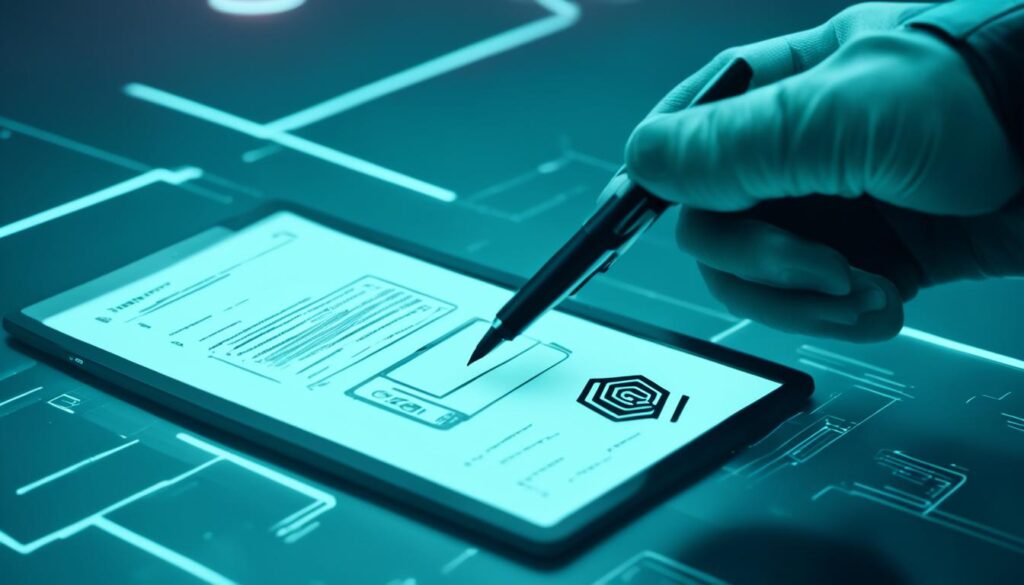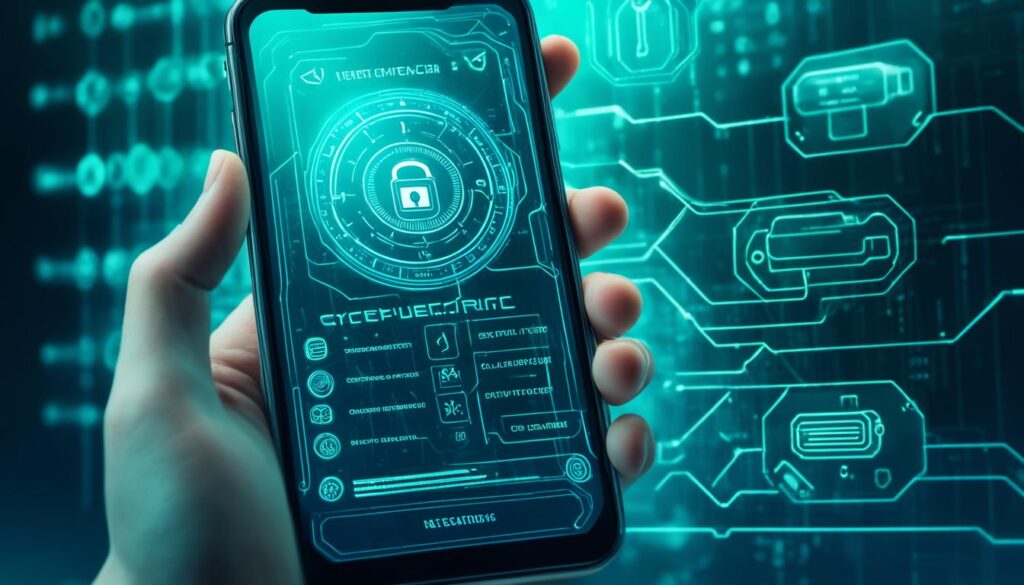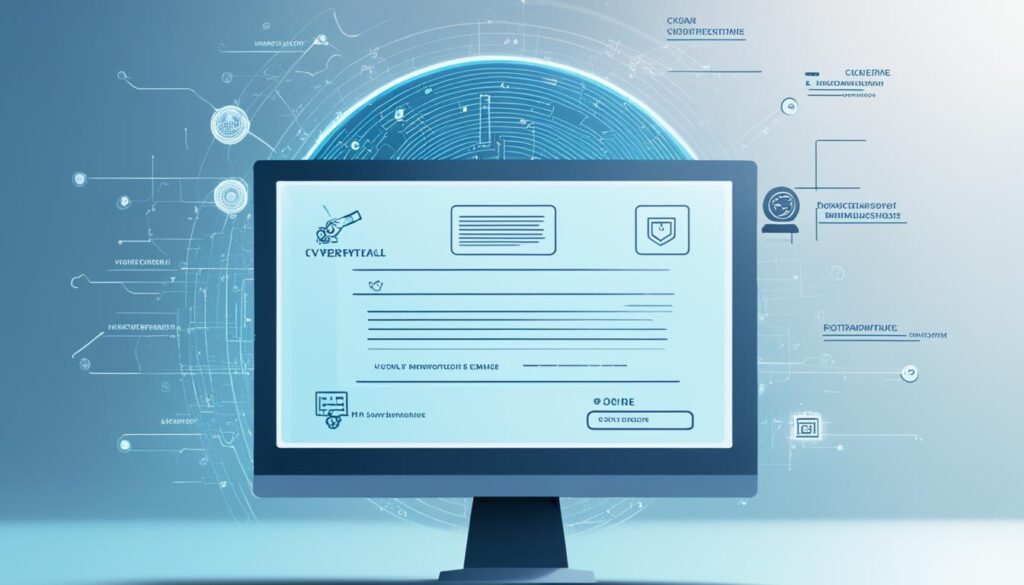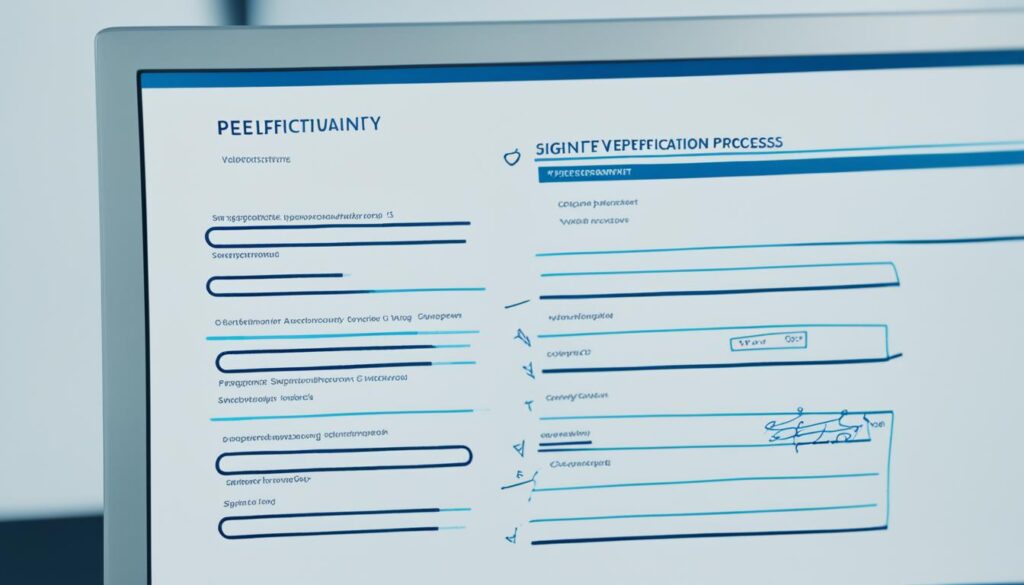In an age where over 700 billion pieces of mail are delivered by the U.S. Postal Service annually, the rise of electronic signatures as a legal and secure alternative is significant. Businesses aiming to streamline operations are turning to an efficient signature verification process that ensures accuracy and security, while also embracing trusted methods. In fact, electronic signatures have proven to accelerate agreement finalizations by up to 80%, underscoring the demand for speed in today’s digital-first environment.
The cumbersome days of waiting for a parcel with critical contract papers are fast becoming a relic of the past. Now, verification of signatures can be as instantaneous as the click of a button, anchored securely in the robust frameworks of modern technology. Are you ready to evolve with the times and implement a system that not only speeds up your workflow but also fortifies your document’s integrity?
Key Takeaways
- Electronic signatures significantly speed up document turnaround times, enhancing operational efficiency.
- A secure signature verification process reduces risks and ensures document authenticity.
- Modern businesses need to embrace trusted methods for signature verification to stay competitive and maintain security.
- Accuracy in the signature verification process is key to maintaining legal compliance and avoiding disputes.
- Implementing an efficient signature verification system is integral to transforming traditional workflows into streamlined digital processes.
The Evolution of Signature Processes in Business
The history of business transactions is deeply entwined with the evolution of signature processes, a passage from the painstakingly manual to the seamlessly digital. With each developmental stride, industries have sought to overcome traditional signature limitations, thereby enhancing efficiency and security.
From Wet Ink to Digital: The Shift in Signature Collection
Wet ink signatures have long been the bedrock of contract authentication. Yet, the relentless pace of global business has rendered this method inconvenient and outdated. The shift towards digital signature solutions symbolizes a transformation aimed at expediting deals and fostering international collaboration without the hindrance of geographical barriers.

Overcoming the Limitations of Traditional Signatures
In an arena where time equates to currency, the protracted nature of traditional signatures signaled a need for change. The rise of digital signature solutions was not merely a nod to technological progress but a necessary step to surmount inefficiencies. From the annals of offices laden with paper, businesses have progressed to a realm where agreements are secured with clicks, not pens.
- Enhanced Security: Digital signatures offer greater protection against forgery and tampering, safeguarding business interests.
- Expediency: Eliminating the need for physical mailing leads to faster transaction completions.
- Cost Reduction: The digital approach reduces expenses linked to paper, printing, and courier services.
- Legal Compliance: Digital solutions are designed to comply with global and regional legal frameworks.
The evolution of signature processes is not a closed chapter but an ever-unfolding narrative as businesses continually seek to refine the harmony between legal compliance and technological innovation.
Understanding Electronic Signatures and Digital Signatures
In today’s fast-paced digital landscape, the digitization of signatures has transformed the way we authorize documents and conduct business. While the convenience of clicking to confirm is undeniable, it’s critical to grasp the nuances that distinguish electronic signatures from their more secure counterparts—digital signatures.
At their core, electronic signatures serve as an electronic means to offer consent or approval on digital documents. This could be anything from a simple typed name to an uploaded image of a handwritten signature. However, they are often accompanied by legal verification problems because they don’t inherently secure the document’s content—that’s where digital signatures come into play.
Digital signatures, a subset of electronic signatures, include additional layers of security. They utilize cryptography to lock the document and validate the signer’s identity. This method effectively minimizes the risk of unauthorized alterations post-signature—a paramount concern in the realm of electronic signature verification.

When we consider the complication of legal verification problems, we must acknowledge that digital signatures provide a stronger defense. They come equipped with a certificate-based digital ID, typically issued by a trusted certificate authority, making the verification process more robust and legally binding.
| Electronic Signatures | Digital Signatures |
|---|---|
| Any electronic symbol attached or logically associated with a document | Secure electronic signatures with cryptographic protection |
| Can be as simple as a name typed at the end of an email | Requires a digital certificate to validate the signer’s identity |
| Potential for legal challenges such as timing and authenticity | Strong legal standing due to compliance with specific standards |
| Lacks integrated document tampering detection | Document integrity is protected, tampering is detectable and traceable |
The evolutionary step from electronic signatures to digital signatures is a critical leap in securing transactions and maintaining trust in this digital age. It’s far more than just the digitization of signatures; it’s about ensuring that every electronic endorsement carries the weight and assurance of a traditional handshake.
The Legal Framework: ESIGN Act and eIDAS Regulation
The legal landscape of electronic signatures has been dramatically reshaped by the advent of major legislative acts designed to promote their legal acceptance and streamline electronic commerce. Two pivotal statutes, the ESIGN Act in the United States and the eIDAS regulation in the European Union, serve as the legal backbone supporting the use and enforceability of electronic signatures.
Federal and European Laws Governing eSignatures
The Electronic Signatures in Global and National Commerce (ESIGN) Act, established in 2000, marked a significant stride in the United States towards the universal recognition of electronic signatures. It ensures that electronic contracts and signatures hold the same weight as their paper counterparts, fostering a legal environment conducive to digital transactions. On the other side of the Atlantic, the European Union implemented the electronic IDentification, Authentication and trust Services (eIDAS) regulation in 2016, which standardizes electronic identification and trust services for electronic transactions within the EU, guiding both individuals and businesses within the digital marketplace.
Legal Acceptance and Enforcement of Electronic Signatures
Undoubtedly, the legal framework established by these regulations has been instrumental in the widespread legal acceptance and enforcement of electronic signatures. They embolden organizations to conduct business electronically with confidence, knowing there is a reliable structure in place that supports the legitimacy and legal enforceability of their electronic agreements, both domestically and across borders.
| Aspect | ESIGN Act | eIDAS Regulation |
|---|---|---|
| Geographic Applicability | United States | European Union |
| Type of Signatures Covered | All forms of electronic signatures | Electronic signatures, qualified electronic signatures |
| Legal Impact | Ensures electronic signatures have the same legal status as handwritten signatures | Creates an EU-wide legal framework for electronic identification and trust services |
| Target Entities | Individuals, businesses, and government entities | Individuals, businesses, trust service providers |
The harmonization brought on by the ESIGN Act and the eIDAS regulation not only streamlines cross-border business activities but also advances a digital single market strategy in Europe, revolutionizing how we perceive and perform electronic transactions and signature authentications.
Electronic Signature Verification: Ensuring Document Security
In the digital age, ensuring the integrity and security of documents has become an absolute necessity. Industries across the board are seeking effective ways to prevent signature fraud and guarantee authentic electronic signatures. This thrust towards electronic signature verification is not simply a tech trend, it’s crucial for maintaining trust and confidence in digital transactions.
The Importance of Verifying Electronic Signatures
As we shift away from pen and paper, the importance of verifying electronic signatures becomes increasingly glaring. It’s about more than just confirming a name scribbled on a dotted line; electronic signature verification serves as a robust safeguard, providing an essential layer of document security. Through unique identification mechanisms, one can ensure that the individual signing a document is who they claim to be, and that the agreement is binding and valid.
How Verification Protects Against Signature Fraud
Protection against signature fraud is of paramount importance for individuals and businesses alike. The methods used for electronic signature verification are sophisticated. They delve deep into metadata and utilize rigorous algorithms to ensure that each signature is a genuine mark of consent. These preventive measures are the ramparts guarding against any potential breach or malicious tampering of documentation.

| Features | Benefits |
|---|---|
| Metadata Analysis | Provides an audit trail for legal purposes |
| Encryption Standards | Keeps the content secure from unauthorized access |
| Multi-Factor Authentication | Ensures signer’s identity confirmation |
| Real-Time Alerts and Logs | Tracks each action for timely fraud detection |
The battle against signature fraud is relentless, but with cutting-edge verification technology, the authenticity of an electronic signature can be certified with confidence. Furthermore, by leveraging signature fraud protection protocols, businesses can protect their operations—and their reputation—from the risks associated with falsified electronic signatures.
Signature Verification Process with Advanced Security Measures
The pursuit of a secure signature verification system is a fundamental aspect of any organization’s security strategy. Embracing advanced signature verification methods not only provides a robust line of defense against forgery and fraud but also instills trust in electronic transactions. A key component of these methods is the signature verification process which incorporates several cutting-edge technological solutions aimed at safeguarding the integrity of digital documents.

These methods take advantage of sophisticated algorithms designed to compare and analyze signatures against known authentic samples. Essential to these systems is the use of Public Key Infrastructure (PKI), cryptographic algorithms, biometric data, and behavioral analysis—all crucial in maintaining the veracity of digital communications.
| Verification Method | Function | Benefits |
|---|---|---|
| Cryptographic Hash Functions | Ensure a document’s digital integrity by creating a unique digital fingerprint | Guarantees document authenticity; Changes in content result in a different hash |
| Public Key Infrastructure (PKI) | Uses digital certificates for identifying individual signers | Enhances security by validating user identities through trusted certificates |
| Biometric Verification | Analyzes physical characteristics like fingerprints or iris patterns | Provides an additional layer of security by using unique biological traits |
| Behavioral Analysis | Examines habits like keystroke dynamics and signature motions | Offers nuanced detection of authenticity based on behavior over time |
Considering the advanced nature of threats facing digital security, it’s paramount that businesses prioritize the implementation of a secure signature verification system. The successful integration of these advanced methods not only protects against unauthorized access but also plays a pivotal role in maintaining the stature and reliability of digital transactions in today’s technology-driven world.
Implementing an Automated Signature Authentication System
The advent of automated signature authentication is a game changer for organizations looking to enhance their verification process. By eliminating tedious tasks and incorporating sophisticated technology, these systems are not only accelerating operations but are also fostering more stringent security practices.

Benefits of Automation in Signature Verification
One of the most compelling benefits of automation in the realm of signature verification is the remarkable increase in efficiency. Automating this critical task means reduced time spent on manual oversight and the minimization of errors, leading to a direct improvement in business processes and customer satisfaction. Moreover, automated systems cater to a consistent and tamper-proof verification process, ensuring high standards of legal compliance and document security.
- Reduction in time-consuming manual verification processes
- Minimization of human error in document authentication
- Improved consistency and reliability of verification outcomes
- Strengthened security measures prevent signature fraud
Integrating Automation with Business Applications
Intelligent integration is at the heart of making automated signature verification systems function seamlessly within existing business workflows. Such integrations cater to enhanced business application compatibility, enabling applications to communicate effectively for optimum performance and user experience.
| Business Application | Integration Feature | Automation Benefit |
|---|---|---|
| CRM Systems | Automatic form filling with client data | Streamlined contract initiation and completion |
| Document Management Platforms | Centralized storage and retrieval of signed documents | Improved organization and accessibility of corporate records |
| HR Software | Automated onboarding paperwork processing | Faster employee onboarding and data management |
| Accounting Applications | Synchronisation of signed financial agreements | Enhanced financial verification leading to accurate record-keeping |
The integration of signature verification into various business systems brings forth a smoother, more secure signing process. This translates into reduced overhead for IT departments, a cut in administrative costs, and a bolstered trust in automated processes that align perfectly with the rapid pace of modern business environments.
Digital Signature Validation: What You Need to Know
The integrity of electronic documents hinges on the assured authenticity of digital signatures. At the core of this critical process lies Public Key Infrastructure (PKI) and sophisticated cryptographic techniques, essential components in the modern sphere of digital communication and documentation.
Exploring Public Key Infrastructure (PKI) in Digital Signatures
Public Key Infrastructure plays a pivotal role in establishing a secure environment for online transactions and document signing. PKI employs a set of roles, policies, hardware, software, and procedures required to create, manage, distribute, use, store, and revoke digital certificates. Through PKI, the lifecycle of digital certificates is meticulously managed to ensure digital signature validation is both accurate and reliable.
Cryptographic Techniques for Signature Validation
Underpinning the strength of PKI are the complex cryptographic techniques that safeguard the digital signature process. Cryptography provides the secure encoding and decoding of messages, ensuring that signatures cannot be tampered with or forged. These techniques include the utilization of algorithms that generate a unique digital fingerprint, matched only to the corresponding private key of the signer.
Digital signature validation acts to verify the identity of the signatory and confirms that the document has not been altered after signing. Let’s delve into the key components that constitute the digital validation process:
| Component | Function | Benefit |
|---|---|---|
| Digital Certificates | Link a user’s identity with their public key | Facilitates trust and signer authenticity |
| Encryption Algorithms | Disguise the data into a secure format | Protects signature integrity |
| Hash Functions | Create a unique value for the data set | Ensures data has not changed |
| Certificate Authority (CA) | Issue and manage digital certificates | Maintains a trusted repository of certificates |
| Revocation Lists | Track invalidated certificates | Keeps the validation process current and secure |
It is essential for businesses and individuals alike to understand these components and embrace the use of digital signature validation to maintain the security and veracity of their electronic documents.
As digital transactions and e-commerce continue to grow, the importance of robust digital signature validation procedures cannot be overstated. With the correct implementation of PKI and cryptographic validation techniques, digital certificates serve as the bulwark against fraud and ensure seamless and secure business processes.
Signature Recognition Technology: Modern Solutions for Verification
The advent of signature recognition technology has propelled the security and reliability of electronic signature verification processes to new heights. Utilizing a sophisticated signature comparison algorithm, this technology is capable of distinguishing authentic signatures from forgeries with remarkable accuracy. In today’s digital era, modern electronic signature solutions are witnessing rapid adoption thanks to their ability to seamlessly integrate with business workflows while enhancing legal compliance and security.
One of the most praised advances within this realm is the implementation of dynamic biometric analysis. This method evaluates the natural nuances of each handwritten signature, considering factors such as stroke order, pressure dynamics, and signing speed. Such an approach ensures that every analyzed signature is scrutinized down to the finest detail, affording a high degree of confidence in the authenticity of signed documents.
Let’s take a closer look at how modern electronic signature solutions employ these technologies:
| Technology | Function | Benefits |
|---|---|---|
| Biometric Analysis | Examines the physical act of signing, such as stroke pattern and pressure. | Increases authentication strength and reduces the chances of forgery. |
| Machine Learning Algorithms | Adapts and improves over time to recognize complex signature patterns. | Enhances the accuracy of signature identification through ongoing learning. |
| Signature Comparison | Compares a submitted signature with a stored authentic sample. | Provides a quick and scalable verification process for high-volume transactions. |
The fusion of these technologies into modern electronic signature solutions has paved the way for a more secure and streamlined verification process. Moreover, the flexibility and adaptability of these systems make them suitable for a wide range of industries, each with its unique signature verification demands. Through signature recognition technology, the integrity of electronic transactions is significantly bolstered, reassuring all parties of the legitimacy of their agreements.
The increased ability to spot discrepancies and prevent fraudulent activities before they can affect businesses or consumers is not just a technological triumph; it’s a leap forward in maintaining trust in our ever-evolving digital world. As the landscape of digital transactions continues to expand, the reliance on these advanced verification methods will become even more integral to the security and efficiency of digital business operations.
Choosing the Right Signature Verification Solution for Your Needs
As the digital landscape evolves, so does the need to secure online transactions with reliable signature verification solutions. The right choice can provide not only a robust level of security but also complies with important legal standards.
Assessing Different eSignature Platforms
When assessing eSignature platforms, it’s critical to consider a variety of factors. Security features, the ease of use, and compatibility with your current infrastructure all play a role in the decision-making process. Analyzing the offerings from leaders in the space such as Adobe EchoSign, DocuSign, or e-SignLive can give you a clear understanding of what differentiates each platform and which aligns best with your organizational requirements.
Customizing Solutions for Optimal Security and Compliance
In tailoring a signature verification solution, it’s essential to ensure that it not only provides optimum security but also adheres to regulatory compliance standards. Custom eSignature security solutions should cater to the specific legal and operational needs of an organization, enabling it to uphold industry standards and protect stakeholder interests.
To help delineate the right choice, consider the following factors:
- User Experience: Ensure the platform is intuitive and accessible for all signatories.
- Integration Capabilities: Assess if the platform can seamlessly integrate with your existing workflows and tools.
- Legally Binding: Verify that the eSignatures are legally recognized within the jurisdictions of your operations.
- Scalability: Choose a platform that can grow with your business needs, accommodating more complex signature needs over time.
- Customer Support: Consider the level of customer service provided, including the availability of support and training resources.
By choosing signature verification solutions that fit these criteria, your organization can move forward with confidence, backed by the assurance of security and compliance.
Why Businesses are Adopting Secure Signature Verification Systems
As the digital landscape evolves, organizations are keen on adopting secure signature verification systems due to their undeniable cost-effective advantages and time-saving benefits. These systems represent a critical shift in how companies handle enhanced document management, leading to streamlined operations and reduced overhead costs.
Cost-Effective and Time-Saving Advantages
Traditional signature processes, with all their paper-related expenses and logistical complexities, are becoming a thing of the past. Secure signature verification systems not only cut down on material costs but also slash the delays involved in document circulation. Let’s consider the financial impact:
| Expense Category | Traditional Process | With Signature Verification System |
|---|---|---|
| Material Costs | Paper, ink, and maintenance of printers | Negligible to none |
| Postage/Delivery | Regular expenses on mailing services | Eliminated |
| Time | Days to weeks for document transit | Immediate digital delivery |
| Storage | Physical space for archives | Compact digital storage solutions |
The evidence mounts in favor of the cost-effective advantages as businesses employ digital alternatives to mitigate traditional expense outlays.
Enhanced Document Management and Control
Apart from the evident financial benefits, a secure signature verification system introduces an exceptional level of efficiency into document workflows. Enhanced control over documents means authorization tasks that once took hours can now be achieved with the click of a button. Consider these critical improvements:
- Real-time tracking of document status
- Instantaneous access for authorized users
- Streamlined audit trails for compliance and security
- Minimized risk of document loss or misplacement
By leveraging state-of-the-art verification systems, businesses are not only saving time but also ensuring that every signed document is handled with the utmost integrity and care.
Conclusion
The digital era has brought a sea change to the operational fabric of businesses worldwide, with the signature verification process perched at the frontier of this transformation. By harnessing the potential of secure electronic signatures, organizations are experiencing a significant impact on efficiency. This sweeping optimization swings open the doors to a workspace where processes that once trod through cumbersome paper trails can now soar on the wings of technological agility.
The Impact of Simplified Signature Verification on Organizational Efficiency
It is undeniable that the modernization of the signature verification system propels a leap in organizational efficiency. Introduction of trusted signature methods cuts down on the intricacies involved in handling documents, thus precipitating a thrust in operational velocity. Enterprises that adopt these advancements not only bid farewell to archaic hindrances but also inaugurate a new era of productivity—an era where each process is a cog in a well-oiled machine, ensuring seamless continuity and sterling performance.
Streamlining Business Operations with Secure Electronic Signatures
Integration of secure electronic signatures into everyday business dealings is the cornerstone for streamlining operations. The myriad benefits span across various facets—from bolstering security protocols to slimming down turnaround times. Embracing these sophisticated yet user-friendly secure electronic signatures furnishes a strong defense against fraud, fostering trust within the digital transaction environment. The resultant synthesis—a blend of speed, security, and reliability—heralds a tide of growth, customer satisfaction, and resource optimization that heralds a successful future for businesses willing to evolve with the times.
FAQ
What describes the evolution of signature processes in businesses?
The evolution of signature processes has moved from traditional ‘wet ink’ signatures to secure digital signature solutions. This shift was motivated by the need for efficiency, overcoming the limitations of traditional signature collection, especially in terms of speed and security.
What are the major differences between electronic signatures and digital signatures?
Electronic signatures encompass any electronic indication of an agreement, such as a scanned signature or a tick box. Digital signatures, on the other hand, are a more secure form of electronic signature that uses cryptographic techniques and is linked to the signer’s identity, offering additional layers of legal verification.
How do the ESIGN Act and eIDAS Regulation affect the use of electronic signatures?
The ESIGN Act and the eIDAS Regulation provide a legal framework that supports the use and legal acceptance of electronic signatures. These laws ensure that electronic signatures are as legally enforceable as traditional handwritten signatures in many instances.
Why is electronic signature verification critical for document security?
Electronic signature verification is crucial for document security because it validates the identity of the signatory and ensures the integrity of the signed document. This guards against signature fraud and unauthorized alterations of the document after signing.
What are some advanced security measures used in the signature verification process?
Advanced signature verification methods include biometric signature analysis, cryptographic hash functions, Public Key Infrastructure (PKI), and automated signature authentication systems that safeguard the signing and validation process.
Can signature verification be automated, and what are the benefits?
Yes, signature verification can be automated, offering benefits such as increased efficiency, reduced chances of human error, enhanced document management, and more streamlined integration with existing business applications.
What is Public Key Infrastructure (PKI) and how does it relate to digital signatures?
Public Key Infrastructure (PKI) is a set of roles, policies, hardware, software, and procedures needed to create, manage, distribute, use, store, and revoke digital certificates. In the context of digital signatures, PKI ensures the secure exchange of information and validates the authenticity of digital certificates.
How do modern signature recognition technologies enhance the verification process?
Modern signature recognition technologies use signature comparison algorithms and machine learning to accurately verify the authenticity of signatures. Techniques such as biometric analysis evaluate unique characteristics of the signature, improving accuracy and reliability.
What should be considered when choosing a signature verification solution?
When choosing a signature verification solution, consider the security features, user experience, and specific needs of your organization. Compare different eSignature platforms, assess their compliance with regulations, and determine if they offer customization options to fit your operational requirements.
What are the business advantages of adopting secure signature verification systems?
Adopting secure signature verification systems offers cost and time efficiencies by eliminating the need for physical document handling. It also provides improved document management and control, reducing turnaround times and enhancing overall productivity.
How do simplified signature verification processes impact organizational efficiency?
Simplified signature verification processes have a positive impact on organizational efficiency by streamlining business operations and reducing administrative burdens. They enable quicker document processing, improved security measures, and better resource allocation.





